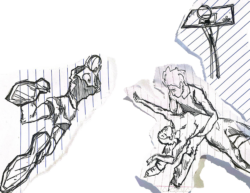The death of a great athlete has cast a shadow over the bright anticipation of the pre-Super Bowl sports world. He was bigger than Brian Urlacher, faster than Marvin Harrison and had more heart than Peyton Manning. His tragic death has exposed a sport with a standard of safety that would be deemed unacceptable for two-legged athletes.
Barbaro, the defending Kentucky Derby champion, was euthanized last Monday after complications resulting from a broken leg he suffered in last year’s Preakness Stakes. Barbaro entered the Preakness with whispers of the mythical Secretariat reborn after winning the Derby by the greatest margin in over half a century. The great throng of supporters that turned out to see the budding legend at Pimlico last year were met with tragedy, as the stallion came up lame shortly after leaving the starting gate. To the bipedal athlete, such an injury would mean a few months of therapy before returning to action. For Barbaro, it meant the beginning of a year-long battle for his life.
The young stallion lost that battle on Monday, and with the interment of his ashes comes talks of ensuring his legacy, a legacy which many believe should include safety reforms. Many sports writers have highlighted some of the more plausible changes that could and should be enacted. The most promising is an artificial surface called Polytrack, which has already been utilized in tracks from Kentucky to California. Polytrack is made of sand and recycled rubber, and is designed to reduce stress on the horse’s back and provide secure footing to prevent leg injury. It is not certain whether or not these surfaces will be effective, but larger tracks should prepare to follow suit if the surface proves effective. Other possible changes include banning two-year-old horses from racing and changing the racing calendar to allow for more time between the Triple Crown races.
Thoroughbred racing, especially in the hallowed venues of the Triple Crown, is entrenched in over a century of tradition. The first Kentucky Derby champion, Aristides, crossed the finish line in 1875. The rules and traditions of Triple Crown racing have changed very little since then, and to think that change will come easily now would be a delusion. But one thing is for sure: the death of Barbaro carries far more weight than the 240 little-known horses that died of racing injuries between 2003 and 2005 in California alone.
Racehorses don’t receive the attention that human athletes do because they are unable to ask for it. You will never see a Derby loser chastising his owner in a press conference á la Terrell Owens, and it is doubtful that you will ever see a Derby winner perform a Chad Johnson victory dance. But in a time of over-hyped and overpaid athletes, this humble silence is priceless. They don’t need to say anything. Just look at the muscles of a thoroughbred straining on the homestretch, and you will know all you need to know of their athletic prowess. I know it seems unreasonable to value the safety of a horse as much as one would a human athlete, but perhaps this will change with the legacy of Barbaro. Many horses can boast victory in one or two legs of the Triple Crown, but being the catalyst for safer horseracing would be the greatest legacy of all.




